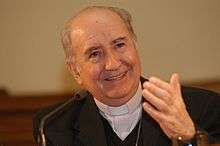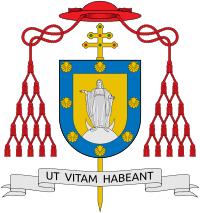Francisco Javier Errázuriz Ossa
| His Eminence Francisco Javier Errázuriz Ossa | |
|---|---|
| Cardinal, Archbishop Emeritus of Santiago de Chile | |
 | |
| Province | Santiago |
| Diocese | Santiago |
| Appointed | 24 April 1998 |
| Installed | 17 May 1998 |
| Term ended | 15 December 2010 |
| Predecessor | Carlos Oviedo Cavada |
| Successor | Ricardo Ezzati Andrello, SDB |
| Other posts |
Cardinal-Priest of S. Maria della Pace Member of the Council of Cardinals |
| Orders | |
| Ordination |
16 July 1961 by Manuel Larraín Errazuriz |
| Consecration |
6 January 1991 by Pope John Paul II |
| Created Cardinal | 21 February 2001 |
| Rank | Cardinal-Priest |
| Personal details | |
| Birth name | Francisco Javier Errázuriz Ossa |
| Born |
5 September 1933 Santiago, Chile |
| Nationality | Chilean |
| Denomination | Roman Catholic |
| Previous post |
|
| Alma mater | |
| Coat of arms |
 |
Francisco Javier Errázuriz Ossa (born 5 September 1933) is a Chilean and the Archbishop Emeritus of Santiago. He is of Basque descent.[1]
| Styles of Francisco Errázuriz Ossa | |
|---|---|
 | |
| Reference style | His Eminence |
| Spoken style | Your Eminence |
| Informal style | Cardinal |
| See | Santiago de Chile (emeritus) |
Early life
Born in Santiago, second of the six children of Pedro Errázuriz Larraín and Marta Ossa Ruíz.
He studied at the Liceo Alemán de los padres del Verbo Divino and later at the Faculty of Engineering of the Pontifical Catholic University of Chile, where he graduated with a bachelor's degree in mathematics in 1953. For 8 years, he was a member of the Student Center and of Federation of Students and joined different university groups of the nascent Schönstatt Movement. Errázuriz befriended the Servant of God Mario Hiriart and with him and other students originated this Marian apostolic movement in Chile.
Errázuriz Ossa attended the State University of Fribourg, Switzerland, where he obtained a licentiate in philosophy and doctorate in theology. Besides his native Spanish, he speaks Italian, German and French.
Priesthood
He was ordained as a priest for the Schönstatt Fathers on 16 July 1961, in Fribourg, by Manuel Larraín Errázuriz, bishop of Talca. In October 1962, he met Fr. Josef Kentenich, founder of the secular Institute of Fathers of Schönstatt, whose spiritual paternity he considers a special gift from God. From 1963 to 1965, Errázuriz was consultor of youth communities and university students in several cities in Chile.
He served as Regional Superior in Chile of the Secular Institute of Fathers of Schönstatt, a position he held from 1965 to 1971. From Chile he directed the community of the institute in the Iberian peninsula and in Ecuador. As Regional Superior, participated in the Conference of clergy in Chile and was elected its vicepresident. During those years he worked with Cardinal Raúl Silva Henríquez, who had welcomed the Institute, then in its organizational phase, in his archdiocese. In 1971 was called to serve his community's General Council in Germany.
He became a member of the General Council of the Institute, from 1971 to 1974. In 1974, he was elected Superior General of the Schönstatt Fathers, and president of the International Council of the Work of Schöntatt; re-elected in 1980 and 1986. Because of his post, he conducted multiple pastoral visits to Europe, America, Africa and Australia. and then became a chaplain in the Schönstatt Movement.
Curial work
On 22 December 1990, Errázuriz Ossa was appointed Titular Archbishop of Hólar and secretary of the Congregation for Institutes of Consecrated Life and Societies of Apostolic Life. He was consecrated on 6 January 1991 in the Lateran Basilica by Pope John Paul II. The principal co-consecrators were Giovanni Battista Re, then the Substitute for General Affairs of the Secretariat of State and Justin Francis Rigali, secretary of the Congregation for Bishops. In the same ceremony, three other future cardinals were also consecrated: Jean-Louis Tauran, Vinko Puljić and Julián Herranz Casado. Errázuriz Ossa adopted the motto: Ut vitam habeant. He attended the IX Ordinary Assembly of the World Synod of Bishops, in the Vatican City, 2–29 October 1994, by papal appointment.
Errázuriz Ossa was named bishop of Valparaíso, Chile, on 24 September 1996. He attended the Special Assembly for America of the World Synod of Bishops, Vatican City, 16 November – 12 December 1997. He was transferred to the metropolitan see of Archdiocese of Santiago, on 24 April 1998. Became the Grand chancellor of the Pontifical Catholic University of Chile the same year. Was elected president of the Chilean Episcopal Conference for three years, on 20 November 1998; and reelected, on 16 November 2001. Elected first vice-president of the Latin American Episcopal Council (CELAM), on 13 May 1999.
Cardinal
He was created Cardinal in the consistory of 21 February 2001 by Pope John Paul II. Errázuriz Ossa received the red biretta and the title of Cardinal-Priest of S. Maria della Pace (Our Lady of Peace). He attended the X Ordinary Assembly of the World Synod of Bishops, Vatican City, 30 September – 27 October 2001. Inducted as member of the Academy of Social, Political and Moral Sciences of the Institute of Chile, Santiago, on 19 December 2002. He was elected president of the Episcopal Council of Latin America (CELAM), for the term from 2003 to 2007 on 16 May 2003. He was one of the cardinal electors who participated in the 2005 papal conclave that selected Pope Benedict XVI in 2005. Attended the XI General Ordinary Assembly of the World Synod of Bishops, Vatican City, 2–23 October 2005; by papal appointment.
During his time as cardinal, Ossa refused to meet with those who claimed to have been abused by clergymen. He also refused public calls for an investigation of Father Fernando Karadima and the issue of clergy sexual abuse more generally. Father Fernando was later found in 2010 to have been an abuser and was forced into retirement.[2] In court testimony, Cardinal Errazuriz asserted that he did not act on allegations he received because he believed them to be untrue. Emails between Errazuriz and his successor as Archbishop of Santiago Cardinal Ezzati were published in 2015 that showed they had conspired together to try to block a Karadima abuse survivor, Juan Carlos Cruz Chellew, from being appointed to Pope Francis' sex abuse commission, calling him a serpent and a threat to the Chilean Church and it's bishops.[3]
Cardinal Errázuriz Ossa's resignation as Archbishop of Santiago was accepted on 15 December 2010. His successor is Ricardo Ezzati Andrello.
He was one of the cardinal electors who participated in the 2013 papal conclave that selected Pope Francis.
On 13 April 2013 he was appointed to a group of cardinals established by Pope Francis, exactly a month after his election, to advise him and to study a plan for revising the Apostolic Constitution on the Roman Curia, 'Pastor Bonus'. The other cardinals are Giuseppe Bertello, president of the Vatican City State governorate; Oswald Gracias from India; Reinhard Marx from Germany; Laurent Monsengwo Pasinya from the Democratic Republic of the Congo; Seán Patrick O'Malley from the United States; George Pell from Australia; and Oscar Andres Rodriguez Maradiaga from Honduras. Bishop Marcello Semeraro will act as secretary for the group. The group's first meeting has been scheduled for 1–3 October 2013. His Holiness is, however, currently in contact with the aforementioned cardinals.[4]
On 14 June 2014, Cardinal Errázuriz Ossa was appointed by Pope Francis to serve as his Special Envoy to WACOM (World Apostolic Congress Of Mercy) III in Bogota, Colombia.[5]
In 2015 it emerged that documents published in Chile show that two of the country's most senior churchmen - including Cardinal Errázuriz Ossa succeeded in blocking one of their country's best known survivors of clerical abuse from being nominated to the Pope's child protection commission. Juan Carlos Cruz had been nominated by the Irish survivor and advocate Marie Collins. Collins, who is a member of the Pope's child abuse commission, has said she was sickened by the revelation that the two Chilean cardinals concerned had interfered with the work of the commission.[6]
See also
| Wikimedia Commons has media related to Francisco Javier Errázuriz Ossa. |
Sources
- ↑ http://www.escritores.cl/base.php?f1=articulos/texto/Penamunoz.htm
- ↑ Now Gathering in Rome, a Conclave of Fallible Cardinals,by Laurie Goodstein, New York Times, 26 February 2013
- ↑ http://www.timesunion.com/news/crime/article/Chile-Catholic-Church-rocked-by-email-scandal-6499285.php&ct=ga&cd=CAEYACoUMTA2ODY4NTE0Mzc2NDAyNjkwNjgyGmM1Njc0MzY2N2U3ZTIzYjI6Y29tOmVuOlVT&usg=AFQjCNG3wHgC1DC-hYJOf_6TIXTOt9CzNA#photo-8616397, retrieved September 13th 2015
- ↑
- ↑ http://press.vatican.va/content/salastampa/en/bollettino/pubblico/2014/08/09/0561/01236.html
- ↑
External links
- Official biography (Spanish)
- Official biography